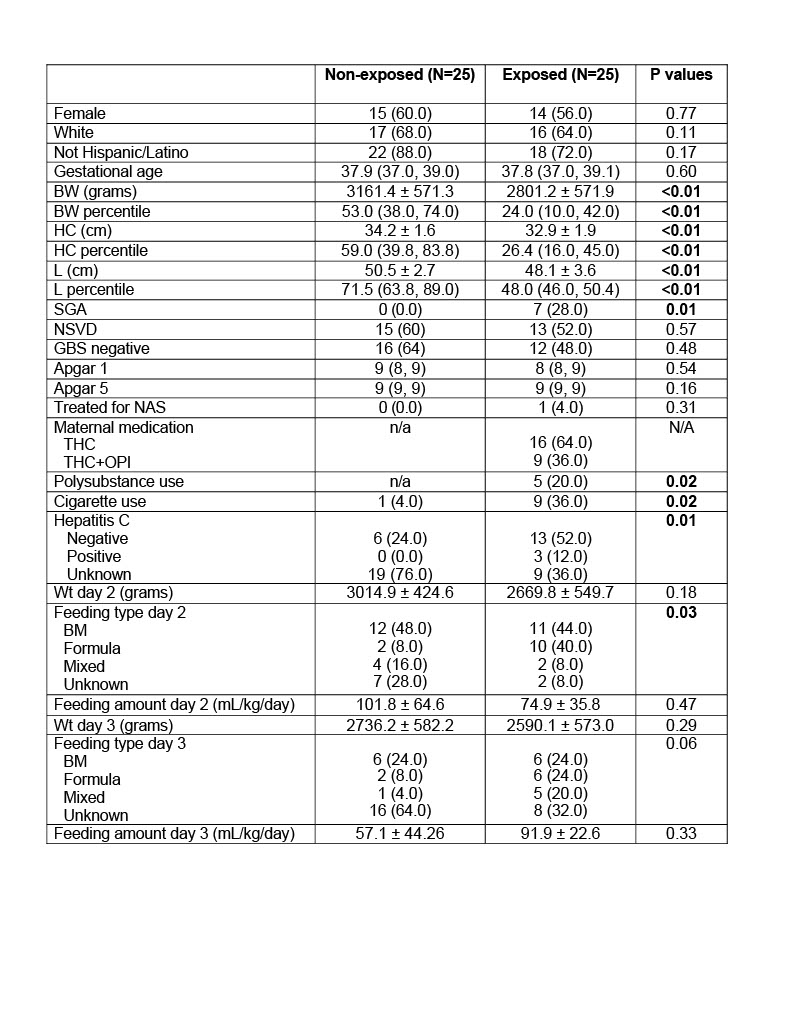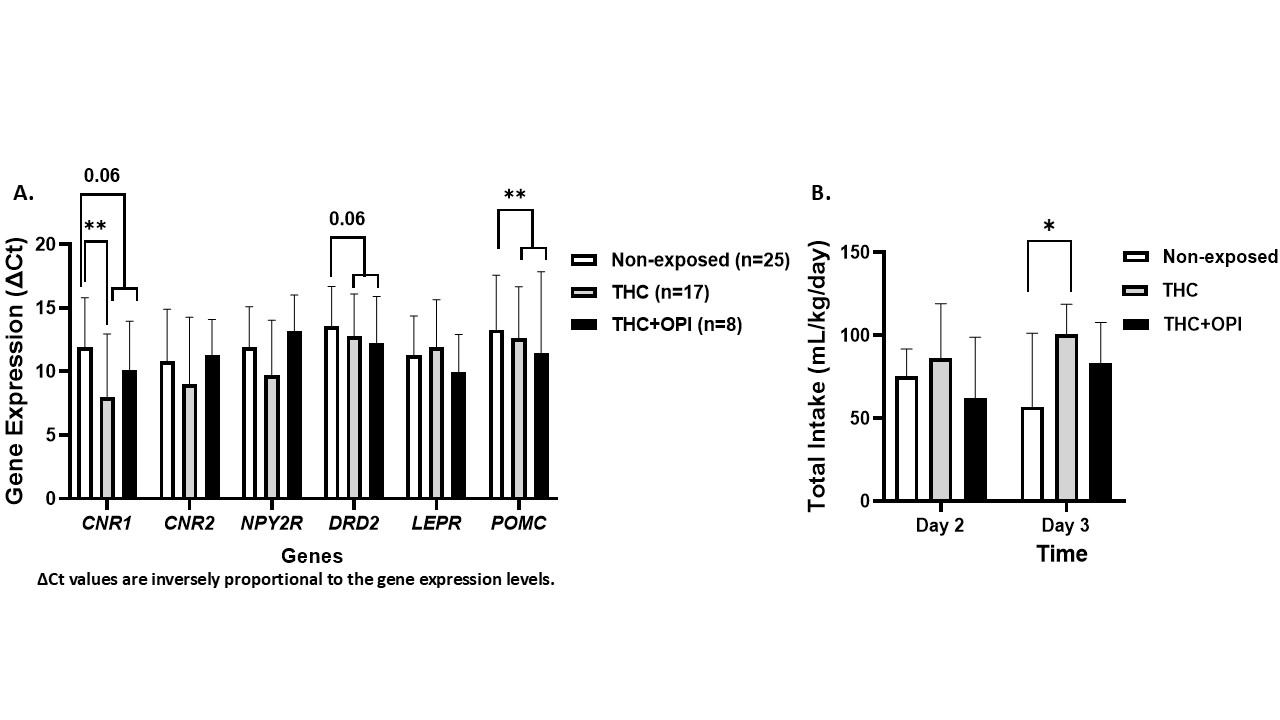Genomics/Epigenomics 2
Session: Genomics/Epigenomics 2
405 - The Molecular Effects of Maternal Cannabis Use on Infant Feeding Regulation
Friday, April 25, 2025
5:30pm - 7:45pm HST
Publication Number: 405.6901
Marissa Chow, Tufts Medical Center, Boston, MA, United States; Natalie Finton, Tufts University, Medford, MA, United States; Kiran Singh, Tufts Medical Center, Boston, MA, United States; Mario Cordova, Tufts Medical Center. Department of Pediatrics, Boston, MA, United States; Elizabeth Yen, Tufts University School of Medicine, Boston, MA, United States
.jpg)
Elizabeth Yen, MD
Associate Professor of Pediatrics
Tufts University School of Medicine
Boston, Massachusetts, United States
Presenting Author(s)
Background: The active ingredient in cannabis, delta-9-tetrahydrocannabinol (THC), binds to cannabinoid receptors and regulates appetite through its effect on the hypothalamic genes. Our laboratory showed that maternal opioid use dysregulates infant feeding by modulating the anorexigenic (leptin receptor/LEPR) and reward (dopamine receptor type 2/DRD2) signaling. The impact of maternal THC use on infant feeding regulation is understudied.
Objective: To determine the effects of maternal THC use (alone [THC-only] or with opioids [THC+OPI]) on the hypothalamic/reward gene regulation and feeding behavior in neonates.
Design/Methods: Saliva samples of THC-exposed (THC-only and THC+OPI) and sex- and gestational age (GA)-matched non-exposed neonates underwent RT-qPCR analysis of select genes: cannabinoid receptors (CNR1, CNR2) and hypothalamic/reward genes (NPY2R, DRD2, LEPR, and POMC). Threshold cycle (Ct) values for these genes were normalized against GADPH and YWHAZ. Gene expression was stratified by exposure. Demographic and feeding data were compared across groups. Continuous data were analyzed using a t-test, and categorical data using a chi-squared test. Significance is set at p< 0.05.
Results: THC-exposed neonates were born smaller than non-exposed neonates (Table). The expression of CNR1 was greater in the THC-exposed than in non-exposed neonates. A trend of greater expression of DRD2 (reward) and POMC (anorexigenic) genes was seen in the exposed than non-exposed neonates. Within the THC-exposed cohort, the expression of DRD2 and POMC was greater in those with THC+OPI exposure than with THC-only exposure (Figure A). THC-only exposed neonates took more volume in the first couple days of life compared to neonates with no drug or with THC+OPI exposure (Figure B). More formula and mix feedings were observed in the THC-exposed than non-exposed group (Table).
Conclusion(s): Maternal THC use affects the hypothalamic/reward genes through its action on the cannabinoid receptor, specifically by upregulating both the reward (DRD2) and anorexigenic (POMC) signaling compared to the non-exposed cohort. Opioids may have a synergistic effect with THC, evidenced by the differential DRD2 and POMC expression. The greater milk intake in the THC-exposed cohort suggests that maternal THC use may create a hypothalamic imbalance that favors reward signaling and promotes feeding. Although limited by a small sample size, our pilot study is the first to show the molecular and behavioral effects of maternal THC use on the offspring’s reward and feeding regulation. Future data will include a larger sample size and more comprehensive feeding data.
Table. Demographic and Feeding Data
 BW=birth weight, HC=head circumference, L=length, SGA=small gestational, Wt=weight, BM=breast milk, DC=discharge, NSVD=normal spontaneous vaginal delivery, GBS=group B staphylococcus, NAS=neonatal abstinence syndrome, THC=delta-9-tetrahydrocannabinol, OPI=opioids, mL=milliliter, kg=kilogram, Data are presented as mean ± standard deviation or median (interquartile ranges) for continuous measures, and N (%) for categorical measures. Bold indicates significance.
BW=birth weight, HC=head circumference, L=length, SGA=small gestational, Wt=weight, BM=breast milk, DC=discharge, NSVD=normal spontaneous vaginal delivery, GBS=group B staphylococcus, NAS=neonatal abstinence syndrome, THC=delta-9-tetrahydrocannabinol, OPI=opioids, mL=milliliter, kg=kilogram, Data are presented as mean ± standard deviation or median (interquartile ranges) for continuous measures, and N (%) for categorical measures. Bold indicates significance.Figure. The Molecular and Behavioral Effects of Maternal THC Use.
 A) THC effects on the hypothalamic regulation are evidenced by a greater reward (DRD2) and anorexigenic signaling (POMC) in the exposed than non-exposed neonates, which may be mediated by THC action on the cannabinoid receptor (CNR1). Opioids may have a synergistic effect with THC on the expression of DRD2 and POMC. B) THC-exposed neonates also had a greater milk intake by DOL 3 compared to the non-exposed neonates. Altogether, these data suggest that maternal THC use may influence infant feeding through its effects on the hypothalamic imbalance, with the predominance of reward signaling. CNR1=cannabinoid receptor type 1, CNR2=cannabinoid receptor type 2, NPYR2=neuropeptide Y2 receptor, DRD2=dopamine receptor type 2, LEPR=leptin receptor, POMC=proopiomelanocortin, THC=delta-9-tetrahydrocannabinol, OPI=opioids, ΔCt=delta threshold cycle, DC=discharge. * p<0.05, ** p<0.01
A) THC effects on the hypothalamic regulation are evidenced by a greater reward (DRD2) and anorexigenic signaling (POMC) in the exposed than non-exposed neonates, which may be mediated by THC action on the cannabinoid receptor (CNR1). Opioids may have a synergistic effect with THC on the expression of DRD2 and POMC. B) THC-exposed neonates also had a greater milk intake by DOL 3 compared to the non-exposed neonates. Altogether, these data suggest that maternal THC use may influence infant feeding through its effects on the hypothalamic imbalance, with the predominance of reward signaling. CNR1=cannabinoid receptor type 1, CNR2=cannabinoid receptor type 2, NPYR2=neuropeptide Y2 receptor, DRD2=dopamine receptor type 2, LEPR=leptin receptor, POMC=proopiomelanocortin, THC=delta-9-tetrahydrocannabinol, OPI=opioids, ΔCt=delta threshold cycle, DC=discharge. * p<0.05, ** p<0.01
